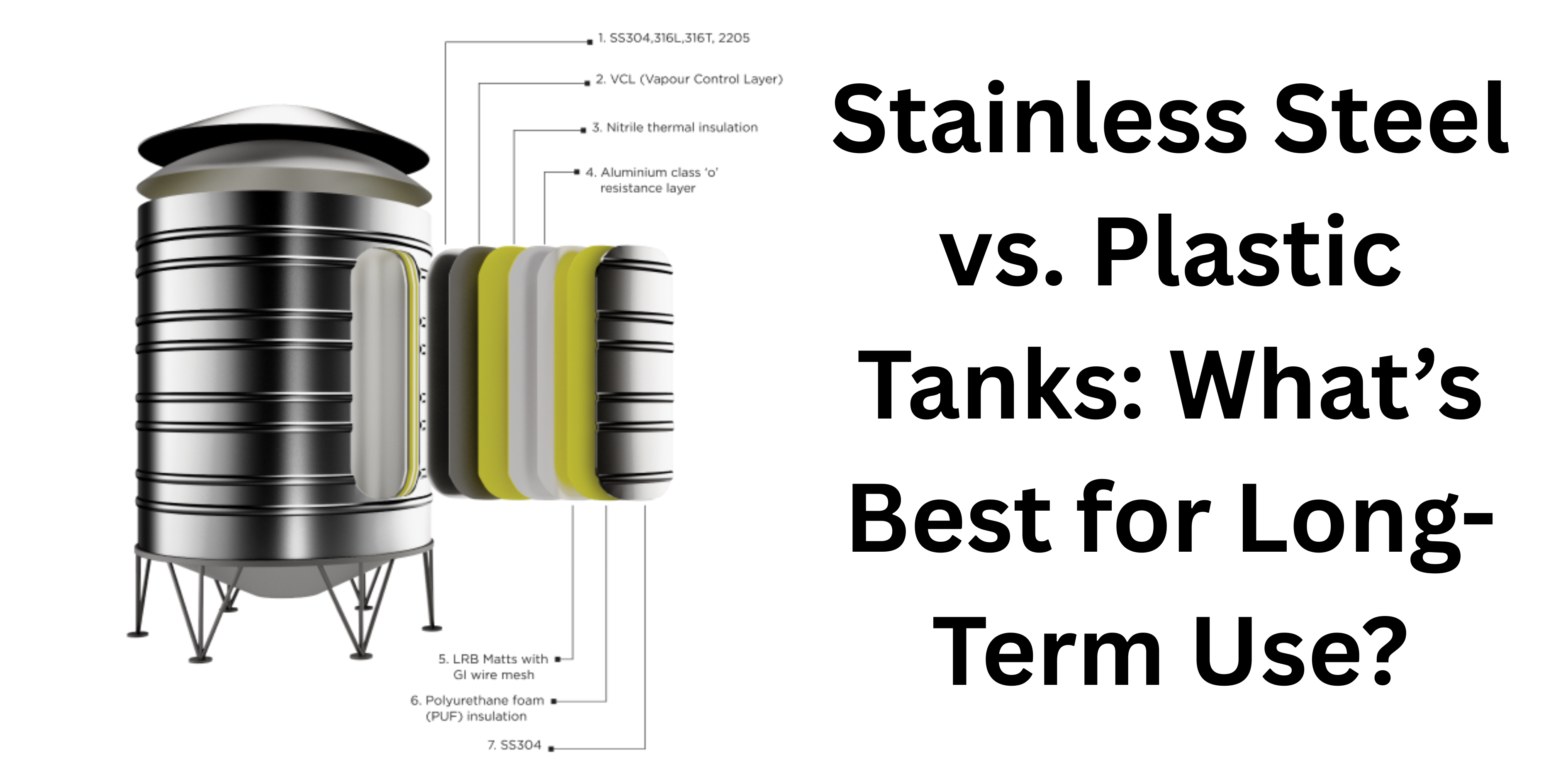
Your water tank works all day and night, but have you ever thought about what it’s made of?
Most people don’t think much about their water tank once it’s installed. But choosing the right type of tank matters a lot. The material of the tank affects how clean your water is, how long the tank lasts, and how well your home’s water system works. As more Indian homes upgrade to modern water systems, picking between a stainless steel water tank and a plastic tank has become more important than ever.
What Are Water Tanks Made Of?
Plastic tanks are very common in India. They’re easier to find, cheaper, and lighter, which makes them easier to move and set up. Polyethylene is what most of these tanks are made of, and they are treated so the sun doesn’t hurt them. They come in a lot of different shapes and sizes, which is good for different kinds of homes.
But now, more people are choosing the stainless steel water tank. These tanks are made from special stainless steel that’s safe for storing drinking water. They are stronger, last longer, and handle weather changes better than plastic. Whether it’s a small home or a tall apartment building, a stainless steel tank is becoming a smart choice for long-term water storage.
Why Does Tank Material Matter Over Time?
Over the years, the type of tank you choose can make a big difference, especially in India’s hot and humid weather.
Handles Heat Better: Plastic tanks can get damaged from strong sunlight. They might fade, become weak, or even crack after a few years. A stainless steel water tank, however, can stay strong in the heat and helps keep the water cooler. It doesn’t bend or break easily under the sun.
Cleaner and Safer: Plastic tanks can grow algae and bacteria if they’re exposed to light or if they get scratched inside during cleaning. This can make the water unsafe to drink. But stainless steel tanks have smooth, shiny surfaces that are easy to clean and don’t let bacteria grow easily. This makes them safer for families with kids or older adults.
More Durable: Plastic tanks can bulge or crack if the water pressure changes or if the weather shifts quickly. A water tank stainless steel is stronger and can handle pressure without changing shape. Whether it’s placed on a rooftop or underground, it will hold up for many years.
Less Work to Maintain: Plastic tanks need regular cleaning and checking for cracks. They might need to be replaced every 7 to 10 years. A stainless steel tank doesn’t need cleaning as often and can last over 20 years with little maintenance.
How Well Do Tanks Work With Water Pumps?
Today, many homes use water systems to make sure water flows smoothly everywhere, from kitchens to showers. The material of your tank plays a role in how well these systems work.
A water pressure pump for home makes sure water flows evenly to all taps and appliances. These pumps need a tank that stays strong under pressure. Plastic tanks can bend or stretch a little, but stainless steel tanks stay firm and help the pump work better.
If you use a pressure pump for shower, it gives you a stronger water flow for a better shower experience. But if the tank feeding the pump is weak or leaks under pressure, it won’t work properly. A stainless steel water tank provides steady water and supports high-pressure systems without issues.
In bigger homes or multi-story buildings, a water booster pump helps water reach the upper floors. For the pump to work well, the tank needs to stay in shape and keep the water steady. Again, stainless steel tanks are better at doing this compared to plastic ones.
Real-Life Things to Think About: Setup, Cost and Safety
Let’s look at some everyday points to help you choose.
Installing the Tank: Plastic tanks are light and easier to move and install. That’s good for homes where space or access is limited. Stainless steel tanks are heavier and might need a stronger base, but once they’re in place, they last longer and don’t need much work.
Cost vs. Value: Plastic tanks are cheaper in the beginning. That’s great if you need a tank quickly or for a short time. But if you plan to stay in your home for many years, a stainless steel tank saves money in the long run. You won’t have to replace it as often, and it keeps your water cleaner.
Water Safety: Low-quality plastic can sometimes leak chemicals into the water, especially in hot weather. This can make the water unsafe. Even better-quality plastic can break down slowly over time. Stainless steel tanks don’t leak chemicals and keep your water tasting fresh and clean.
Better for the Environment: Steel is easier to recycle and creates less waste in the long run. Plastic, once it breaks, often ends up in landfills. If you care about the environment, steel is a better choice.
Final Thoughts
Whether you’re building a brand-new house or replacing an old tank, the type of tank you choose is a big decision. It affects your home’s water quality, your health, and even your comfort.
Plastic tanks are easy and cheap, but stainless steel tanks give you better safety, longer life, and better performance with modern water systems.
Brands like PAQOS have noticed more people asking for smart home water setups—where a stainless steel water tank works together with a water booster pump or pressure pump for shower to give you clean water, good pressure, and peace of mind.
Your water tank isn’t just a container. It’s part of what makes your home work well every day. Choosing the right tank means cleaner water, fewer problems, and a better living experience for years to come.




